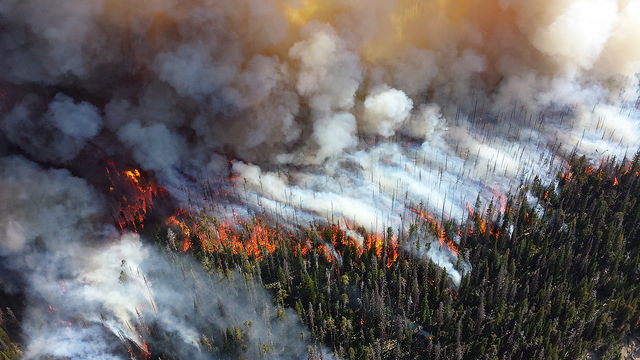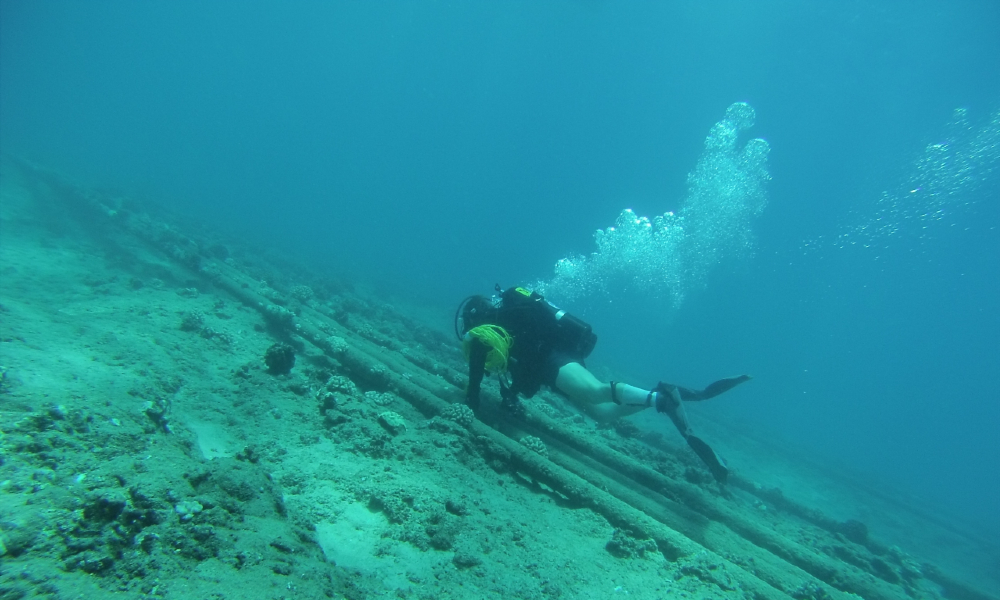Climate Change and National Security, Part I: What is the Threat, When’s It Coming, and How Bad Will It Be?
For more than a decade, the national security agencies of the federal government have repeatedly recognized climate change as a national security threat. Since 2010, the Department of Defense has published at least 35 products explicitly addressing the threat of climate change. The intelligence community has produced at least a dozen more.

Published by The Lawfare Institute
in Cooperation With

For more than a decade, the national security agencies of the federal government have repeatedly recognized climate change as a national security threat. Since 2010, the Department of Defense has published at least 35 products explicitly addressing the threat of climate change. The intelligence community has produced at least a dozen more. These national security reports, and related comments by prominent military officials, reflect a consensus among national security stakeholders that climate change is a critical national security issue. The consensus continues in the Trump administration even though the president himself remains skeptical of climate change. Since January 2017, 18 senior Defense Department officials (including Secretary Jim Mattis) have acknowledged that climate change is a national security issue. In the National Defense Authorization Act for fiscal 2018, Congress also expressed its sense that “climate change is a direct threat to the national security of the United States.”
There is a strong consensus that climate change poses a threat to national security, but the precise nature of the threat and the timeframe over which it will unfold remains uncertain. A comprehensive assessment of any threat requires answers to three separate questions:
- What is nature of the threat;
- When will the threat manifest as such; and
- How much of a threat is it.
This post summarizes the answers that are available.
Climate Change Presents Two Kinds of Threat
As the 2010 Quadrennial Defense Review recognized, climate change presents two distinct types of threats: direct threats to government military installations and indirect geopolitical and global economic threats.
With respect to the threat to military installations, there is consensus that climate change is an existing, and escalating, threat to U.S. military readiness, operations, supply chains and infrastructure because of the direct impact of climate change-related weather events on military facilities such as permanent installations in the U.S., bases and facilities abroad and forward-deployed forces. The unplanned evacuation of 30 ships from U.S. Naval Station Norfolk during Hurricane Florence in September 2018 and the destruction of hangars at Tyndall Air Force Base as a result of Hurricane Michael one month later are only the most recent example of this kind of impact.
Not only are naval bases increasingly threatened by extreme storms and rising sea levels, but other installations are also imperiled by wind, wildfire, drought and erosion related to heavy precipitation events. A 2018 Defense Department survey found that about 50 percent of military facilities in the United States reported at least one impact of climate change on their assets, with airfield operations being the most commonly-affected asset category.
The effects of a changing climate are also being felt on U.S. military facilities overseas. Examples include threats to a munitions complex from erosion attributable to an increase in intense rains and flooding, and a higher number of black flag days due to heat at a base in the Middle East, resulting in the suspension of non-mission essential physical training. Such events reinforce climate change’s enormous long-term financial costs. They also degrade readiness through interruptions of training, testing, and deployments.
The second, indirect type of threat from climate change is not as well defined. Broadly, the Pentagon has explained that climate change “will shape the operating environment, roles and missions that [the Defense Department] undertake[s].” The federal government considers this risk to include geopolitical threats “amplified” by climate change, as well as threats resulting from a more fragile or shock-prone global economic system. The government recognizes that the effects of climate change—long understood to include changes in precipitation and the hydrological cycle, more intense storm events, increases in the severity and frequency of drought, warmer mean air temperature, rising sea levels and ocean acidification, greater risks of wildfire, changes in plant and animal ranges, and changes in Arctic sea-ice extent and thickness—will have diverse impacts. Some of these potential impacts include food crises due to precipitation changes in Central America; saltwater intrusion and flooding leading to increased migration in South Asia; the potential for conflict over increasingly scarce water resources in North Africa; and social and political collapse due to catastrophic storm events.
And these impacts may already be occurring. Scholars and the news media have begun to highlight the nexus between climate change and geopolitical developments. They have, suggesting a link between climate-related food insecurity and increased migration from Central America and insurgency groups in northern Mali.
Three Critical Uncertainties
But if the national security apparatus has at least grappled with the question of what kinds of threats attend climate change, they have been less forthcoming in addressing the second and third parts of the threat assessment: the “when” and “how much” questions. With respect to the second type of threat from climate change, addressing these questions is a fraught exercise even in the best of circumstances. Evaluating how fast climate change will occur and how bad it will get is challenging for three distinct reasons.
First, although the climate has already started warming, the ultimate severity of climate change will be determined in large part by global emission levels in the next few decades. Because of the level of greenhouse gases already in the atmosphere, it is virtually certain that the world will experience 1.5 to 2 degrees Celsius of warming above pre-industrial levels (although there is substantial evidence that there is a big difference for the planet between warming of 1.5 versus 2 degrees). Whether warming is limited to that range, or reaches significantly higher depends in large part on what happens in the coming decades. In recent regulatory documents, the Trump administration projected potential warming of 4 degrees Celsius by 2100, assuming the world remains on its current course; this may be an underestimate if countries do not fulfill their current pledges to reduce emissions. The trajectory of emissions over the next several years or decades will determine the long-term severity of climate change, and therefore will likely dictate the intensity of the national security threat. Estimating this emissions trajectory requires making informed guesses on a host of trends—ranging from economic growth to the pace of technological development—that are themselves uncertain.
Second, it is and will remain difficult to attribute any particular national security incident directly to climate change. How individual or multiple climate-related events—droughts, wildfires, or storms, for example—impact U.S. national security depends on how those events are mediated through particular social, economic and political circumstances. In a country with weak governing institutions (for example, Sudan), severely limited water resources resulting from a prolonged drought could lead to food insecurity and contribute to rising social, ethnic or political tensions, or spur mass migration. Yet in a country with relatively well-developed capabilities and financial and institutional resources (say, the United States), the same resource scarcity might have relatively minor impacts.
Although the impacts of climate change will be felt most acutely in countries with relatively weak adaptive capacity, even countries with high adaptive capacity are vulnerable to the impacts of climate change. For example, a severe drought could hobble or completely disrupt shipping in central Europe by making waterways impassable to large cargo ships, disrupting trade and creating economic ripples throughout the developed world. Regardless of the level of adaptive capacity, if and when climate-related events trigger conflict or mass migration is likely to depend on a mix of circumstances that will be difficult to predict ex ante.
Third, it is not clear how fast climate change will proceed. Planetary warming has thus far followed a fairly linear trajectory, and if warming continues at its current rate, it will be decades before the full impact of today’s emissions are felt. But there is also reason to think that warming could accelerate, perhaps dramatically. The pace of warming depends in part on the trajectory of emissions, but also on whether the planet will reach a climate tipping point, after which positive feedback loops will trigger “runaway” (read: uncontrollable and potentially irreversible) climate change. There are many of these so-called feedback loops; for example, the loss of Arctic sea ice, which currently reflects incoming radiation, could result in further warming. Similarly, if melted, Arctic permafrost could release many tons of methane—a highly potent greenhouse gas—into the atmosphere, which would trigger more warming. Scientists do not know at what point each of these positive feedback loops would be triggered. After outlining several potential positive feedback loops, the Intergovernmental Panel on Climate Change (IPCC), in its most recent comprehensive evaluation of the science of climate change, concluded that there is “little consensus on the likelihood of such events over the 21st century.”
In short, inherent uncertainty about the ultimate emissions trajectory, scientific uncertainty about potential climate tipping points and the complexity of the interaction between climate and human systems all inhibit the government’s ability to produce meaningful reports on the national security implications of climate change. The national security community has worked to address some of these gaps, including by commissioning reports that provide more detailed analysis of the impact of climate change on particular regions to 2030 (see government-commissioned reports on Russia; Southeast Asia; China; India; Mexico and Caribbean; North Africa). Similarly, the best government analysis provides specific examples of the threats posed by climate change, with references to the time periods over which they are likely to occur.
For now, that may be the best they can do. At least in its public analysis, the government relies on the reports produced by the IPCC for its scientific baseline. The IPCC’s comprehensive assessments, which are authoritative reflections of scientific consensus on climate change, are massive undertakings, released about every seven years. The IPCC is not slated to finalize its next major assessment of climate change until 2022 (although it will release two special reports in 2019, one on the impact on oceans and the cryosphere and the other on land management, desertification, and food security). Because much of the national security analysis of climate change hinges on this scientific baseline, the publicly available national security analysis of climate change is unlikely to change much before 2022. Until the scientific baseline on the pace and scope of climate change is further refined, expect increasingly persistent but relatively general claims that climate change is a threat to national security.





